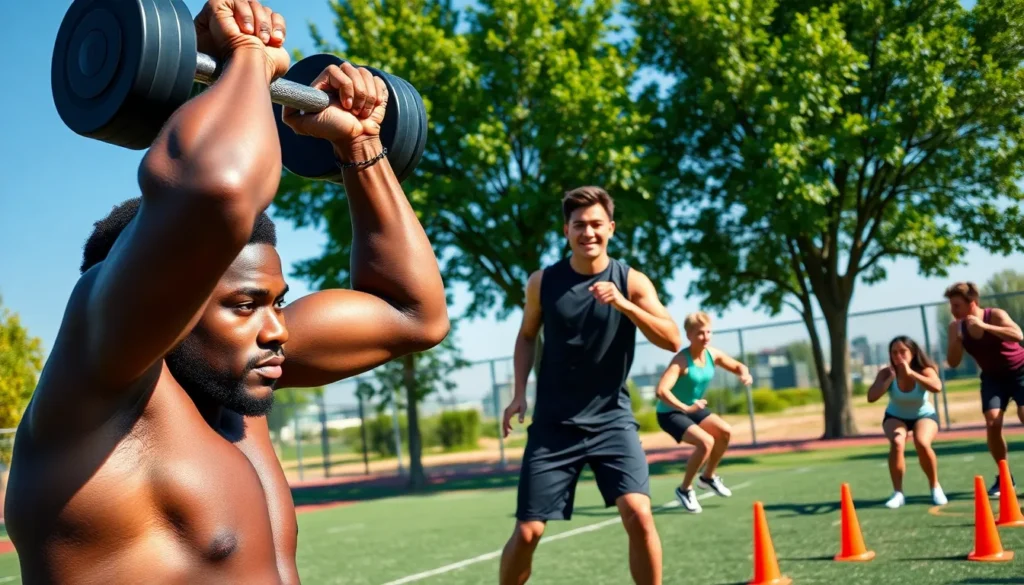Table of Contents
ToggleIn today’s competitive sports environment, the role of fitness training has never been more crucial. Athletes are constantly looking for ways to elevate their performance, reduce injury risk, and enhance their overall physical conditioning. Fitness training serves as the backbone for many successful sports careers, making it essential for anyone serious about improving their game. This article delves into the importance of fitness training in sports, explores emerging trends, and offers insights on nutrition and recovery strategies to maximize athletic effectiveness.
The Importance of Fitness Training in Sports

Fitness training is fundamental for athletes, providing a foundation on which they can build their skills and agility. Without an adequate fitness regimen, even the most talented athletes may struggle to achieve their full potential.
Benefits of Regular Fitness Training
Engaging in regular fitness training offers numerous benefits:
- Increased Strength and Endurance: Regular workouts enhance muscle strength and cardiovascular endurance, essential for sustaining high performance during competitions.
- Enhanced Flexibility: Flexibility training can reduce the risk of injury, allowing athletes to move more freely.
- Weight Management: Maintaining a healthy body weight is crucial for optimal performance, and fitness training plays a key role.
- Mental Resilience: A rigorous training routine can improve mental toughness, which is vital for overcoming challenges on and off the field.
Common Types of Fitness Training in Sports
Athletes typically engage in various types of fitness training, tailored to their specific sports. Some common methods include:
- Strength Training: Focusing on building muscle mass and strength through weight lifting and resistance exercises.
- Aerobic Training: Activities like running, swimming, or cycling that enhance cardiovascular fitness.
- Flexibility Training: Incorporating stretching exercises to improve the range of motion and prevent injuries.
- Agility Training: Drills designed to enhance quickness and footwork, vital for sports like soccer or basketball.
Emerging Trends in Fitness Training
The fitness training landscape is rapidly evolving, driven by advancements in technology and shifts in training philosophies.
Technology in Fitness Training
The integration of technology into fitness training is transforming how athletes train:
- Wearable Devices: Fitness trackers and heart rate monitors offer real-time data, allowing athletes to monitor their performance and recovery closely.
- Training Apps: Mobile applications provide tailored workouts, track progress, and connect athletes with coaches remotely.
- Virtual Reality: Some athletes are starting to use VR for simulated training scenarios, enhancing their tactical training abilities in an immersive environment.
Personal Training vs. Group Training
Another trend gaining traction is the choice between personal and group training:
- Personal Training: Offers a one-on-one experience, allowing for tailored workouts to meet specific athletic needs and goals.
- Group Training: Fosters camaraderie and competition, motivating athletes through social interactions while benefiting from shared coaching tips.
Nutrition and Recovery in Fitness Training
Nutrition and recovery play a pivotal role in the effectiveness of fitness training. An athlete’s diet can significantly impact their performance, while proper recovery strategies ensure they remain in peak condition.
Essential Nutrients for Athletes
A well-balanced diet for athletes should include a variety of essential nutrients:
- Proteins: Crucial for muscle repair, athletes should aim for lean sources such as chicken, fish, and legumes.
- Carbohydrates: The primary energy source for high-intensity training, complex carbs like whole grains should dominate their diet.
- Fats: Healthy fats from sources like avocados, nuts, and olive oil provide sustained energy.
- Vitamins and Minerals: Micronutrients support overall health and are vital for energy production and recovery.
Recovery Strategies Post-Training
Effective recovery strategies are key to optimizing performance after workouts:
- Hydration: Replenishing fluids lost through sweat helps prevent dehydration and promotes recovery.
- Active Recovery: Light activities such as walking or yoga can promote blood flow and expedite recovery.
- Sleep: Adequate rest is essential for muscle repair and mental refreshment, making it a critical component of any training regime.
Creating an Effective Fitness Training Plan
An effective fitness training plan is tailored to the specific needs and goals of the athlete, incorporating various elements that can drive success.
Setting Realistic Fitness Goals
Establishing SMART (Specific, Measurable, Achievable, Relevant, Time-bound) goals is crucial:
- Specific: Define the exact outcome desired, whether it’s improving sprint time or increasing muscle mass.
- Measurable: Incorporate metrics to track progress, such as weights lifted or distance run.
- Achievable: Set goals that push limits but are eventually attainable within a designated timeframe.
- Relevant: Ensure that the goals align with the athlete’s long-term ambitions.
- Time-bound: Create deadlines to foster accountability and motivation.
Measuring Progress and Adjusting Training
Regular assessment of progress allows for adjustments to maintain effective training:
- Fitness Assessments: Conduct regular evaluations to monitor improvements in strength, endurance, and overall fitness.
- Training Logs: Keeping a detailed log helps in identifying patterns and areas for improvement, facilitating personalized adjustments.
Conclusion
In the ever-evolving world of sports, fitness training continues to be a crucial component for success. By understanding the importance of fitness training, embracing emerging trends, prioritizing nutrition and recovery, and actively creating a tailored fitness plan, athletes can maximize their potential. The journey of an athlete is not just about honing skills on the field: it is also about the relentless pursuit of physical fitness that can make all the difference in their performance.







